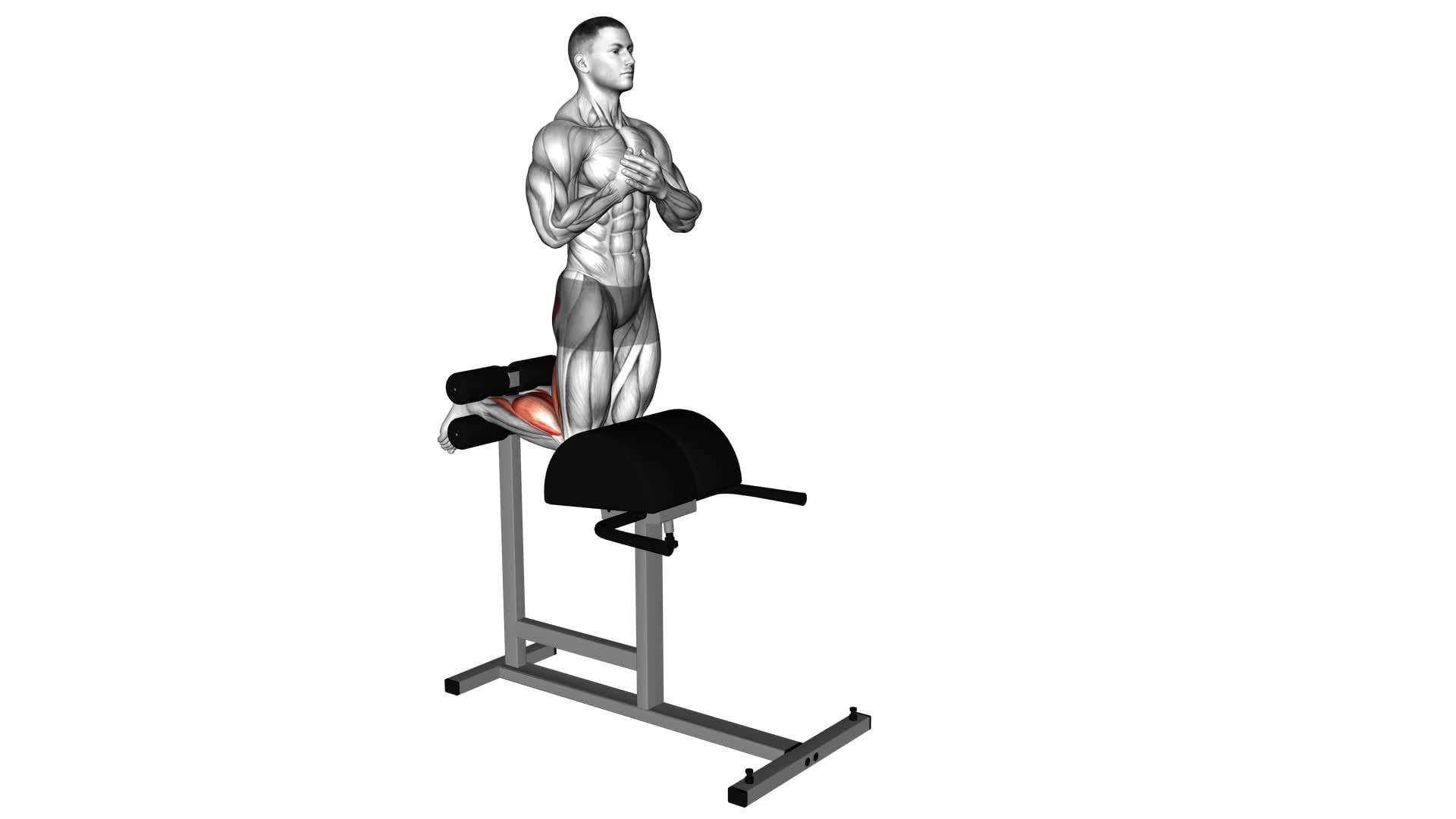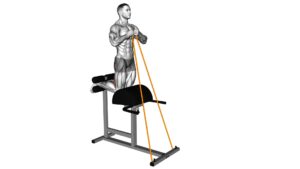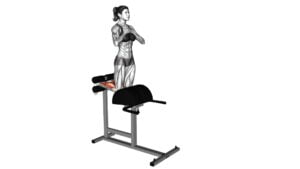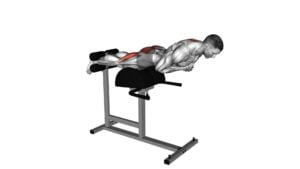Glute Ham Raise (VERSION 2) – Video Exercise Guide & Tips

In this video exercise guide, you'll learn all about the Glute Ham Raise (Version 2) and how it can benefit you. Proper form and technique will be emphasized, along with progression and modification options to suit your fitness level.
Watch This Exercise Video
Avoid common mistakes and follow these tips to maximize your results. Get ready to strengthen and sculpt your glutes and hamstrings like never before.
It's time to take your workout to the next level!
Key Takeaways
- The Glute Ham Raise strengthens the glutes and hamstrings.
- It targets different muscle groups and enhances effectiveness with variations and equipment.
- It improves lower body strength and stability.
- There are progression and modification options available for continual progress in strength and muscle development.
Benefits of the Glute Ham Raise (Version 2)
If you're looking to strengthen your glutes and hamstrings, the Glute Ham Raise (Version 2) can provide you with numerous benefits. This exercise is a variation of the traditional Glute Ham Raise, and it offers additional challenges and targets different muscle groups.
One of the main benefits of the Glute Ham Raise (Version 2) is that it helps to develop stronger glutes and hamstrings, which are essential for overall lower body strength and stability. By incorporating variations of the exercise, such as using different equipment or adjusting the angle of the bench, you can further enhance the effectiveness of this workout.
The Glute Ham Raise (Version 2) can be performed using a glute ham developer machine or a stability ball. These pieces of equipment provide the necessary support and stability to execute the exercise correctly. Adding resistance bands or weights can also increase the difficulty and target the muscles even more. By constantly challenging your muscles with different variations and equipment, you can continue to make progress and see improvements in your strength and stability.
Proper form and technique are crucial when performing the Glute Ham Raise (Version 2). Transitioning into the subsequent section, it's important to understand how to execute this exercise correctly to maximize its benefits and minimize the risk of injury.
Proper Form and Technique
To perform the Glute Ham Raise (Version 2) with proper form and technique, ensure that you use a controlled and fluid motion throughout the exercise. This will help you maintain correct alignment and activate the appropriate muscles. Here are some key points to keep in mind:
- Start by adjusting the footplate so that your ankles are comfortably secured. Your knees should be positioned just behind the pad, with your thighs resting on it.
- Engage your glutes and hamstrings as you lower your upper body towards the ground. Keep your core engaged to maintain stability.
- As you raise your upper body back up, focus on using your glutes and hamstrings to drive the movement. Avoid using your lower back or relying on momentum.
- Throughout the exercise, keep your spine neutral and avoid any excessive arching or rounding.
- Squeeze your glutes at the top of the movement to maximize muscle activation.
- Remember to breathe steadily throughout the exercise, inhaling as you lower down and exhaling as you raise back up.
Progression and Modification Options
To progress and modify the Glute Ham Raise (Version 2), consider incorporating variations such as weighted GHRs, single-leg GHRs, or GHR negatives. These progression options and modification variations can help you challenge your muscles in new ways and continue to make progress with your Glute Ham Raise exercises.
One progression option is to add weights to your Glute Ham Raise. This can be done by holding a dumbbell or a weight plate against your chest while performing the exercise. The added resistance will increase the difficulty and intensity of the movement, helping you build stronger glutes and hamstrings.
Another option is to perform single-leg GHRs. This variation shifts the focus to one leg at a time, increasing the challenge and requiring more stability and control. By working each leg separately, you can address any strength imbalances and improve overall leg strength.
Lastly, GHR negatives can be a valuable modification variation. Instead of lifting yourself up, focus on the lowering phase of the exercise. This eccentric movement places a greater emphasis on the muscles and can help you build strength and control.
Incorporating these progression options and modification variations into your Glute Ham Raise routine will keep your workouts challenging and help you continue to make progress in your strength and muscle development.
Common Mistakes to Avoid
To avoid common mistakes when performing the Glute Ham Raise (Version 2), focus on maintaining proper form and engaging the correct muscles throughout the exercise. Here are some common mistakes to watch out for:
- Allowing the lower back to round: Keep your back straight throughout the movement to prevent unnecessary strain on the spine and ensure proper muscle activation.
- Using momentum: Avoid using momentum to lift your body up. Instead, focus on engaging your hamstrings and glutes to perform a controlled and deliberate movement.
- Neglecting the core: Your core muscles play a crucial role in stabilizing your body during the exercise. Make sure to engage your core by contracting your abs and maintaining a stable position throughout.
By avoiding these common mistakes, you can optimize your Glute Ham Raise (Version 2) and maximize your results.
Now, let's move on to some tips for maximizing your results and getting the most out of this exercise.
Tips for Maximizing Results
To maximize your results with the Glute Ham Raise (Version 2), focus on these key tips. Incorporating effective workout strategies and following proper nutrition tips for muscle growth will help you achieve optimal results.
One effective workout strategy is to vary the intensity of your Glute Ham Raise (Version 2) sessions. Gradually increase the number of repetitions and sets as your muscles adapt to the exercise. Additionally, you can add resistance by holding a weight plate or wearing a weighted vest. This will challenge your muscles and promote muscle growth.
Proper nutrition is essential for muscle growth. Make sure you consume enough protein to support muscle repair and growth. Aim for a protein-rich meal or snack within an hour after your Glute Ham Raise (Version 2) workout. Include lean sources of protein such as chicken, fish, eggs, or protein shakes in your diet.
Incorporating carbohydrates into your diet is also important to fuel your workouts and replenish glycogen stores. Choose complex carbohydrates like whole grains, fruits, and vegetables. These will provide sustained energy throughout your workout and aid in muscle recovery.
Lastly, don't forget to stay hydrated. Drink plenty of water before, during, and after your workouts to support optimal performance and muscle function.
Frequently Asked Questions
How Many Sets and Reps Should I Do for the Glute Ham Raise (Version 2) Exercise?
To progress in the glute ham raise (version 2) exercise, start with 3 sets of 8-10 reps. Gradually increase the number of sets and reps as your strength improves.
Avoid common mistakes like using momentum or relying too much on your lower back.
Focus on engaging your glutes and hamstrings throughout the movement.
Maintain proper form and control to get the most out of this exercise.
Can I Perform the Glute Ham Raise (Version 2) Exercise if I Have Lower Back Pain?
If you're dealing with lower back pain, it's important to consider modifications for the glute ham raise exercise. This exercise can put strain on your lower back, so it's crucial to take precautions.
One modification you can try is reducing the range of motion by not going as far down during the exercise.
Additionally, you may want to consult with a healthcare professional or a certified trainer to ensure you're performing the exercise correctly and safely.
Are There Any Alternative Exercises That Target the Same Muscles as the Glute Ham Raise (Version 2)?
If you're looking for alternative exercises that target the same muscles as the glute ham raise (version 2), there are a few options you can consider.
One alternative is the Romanian deadlift, which focuses on the hamstrings, glutes, and lower back.
Another option is the hip thrust, which primarily targets the glutes.
Both of these exercises can provide similar benefits to the glute ham raise (version 2) in terms of muscle activation and strength development.
Is It Necessary to Use a Glute Ham Raise Machine to Perform This Exercise, or Can I Do It With Other Equipment?
To perform the glute ham raise, you don't necessarily need a specific machine. There are alternative exercises that target the same muscles without equipment. You can try variations like the Nordic hamstring curl, Swiss ball hamstring curl, or single-leg Romanian deadlift.
These exercises engage the glutes and hamstrings effectively, helping to strengthen and tone those muscles. Remember to maintain proper form and gradually increase the intensity as you progress.
How Often Should I Incorporate the Glute Ham Raise (Version 2) Exercise Into My Workout Routine?
To incorporate the glute ham raise (version 2) into your workout routine, it's important to consider the benefits and variations of this exercise.
This exercise primarily targets your glutes and hamstrings, helping to strengthen and tone these muscle groups.
You can perform the glute ham raise (version 2) using a glute ham raise machine or other equipment such as a stability ball or resistance bands.
It's recommended to include this exercise 2-3 times a week in your comprehensive lower body workout routine for optimal results.
Conclusion
In conclusion, the glute ham raise (version 2) is a highly effective exercise for targeting and strengthening the glutes and hamstrings.
By following proper form and technique, utilizing progression and modification options, and avoiding common mistakes, individuals can maximize their results from this exercise.
Incorporating these tips into your routine will help you achieve optimal performance and enhance your overall lower body strength and stability.

Author
Years ago, the spark of my life’s passion ignited in my mind the moment I stepped into the local gym for the first time. The inaugural bead of perspiration, the initial endeavor, the very first surge of endorphins, and a sense of pride that washed over me post-workout marked the beginning of my deep-seated interest in strength sports, fitness, and sports nutrition. This very curiosity blossomed rapidly into a profound fascination, propelling me to earn a Master’s degree in Physical Education from the Academy of Physical Education in Krakow, followed by a Sports Manager diploma from the Jagiellonian University. My journey of growth led me to gain more specialized qualifications, such as being a certified personal trainer with a focus on sports dietetics, a lifeguard, and an instructor for wellness and corrective gymnastics. Theoretical knowledge paired seamlessly with practical experience, reinforcing my belief that the transformation of individuals under my guidance was also a reflection of my personal growth. This belief holds true even today. Each day, I strive to push the boundaries and explore new realms. These realms gently elevate me to greater heights. The unique combination of passion for my field and the continuous quest for growth fuels my drive to break new ground.



